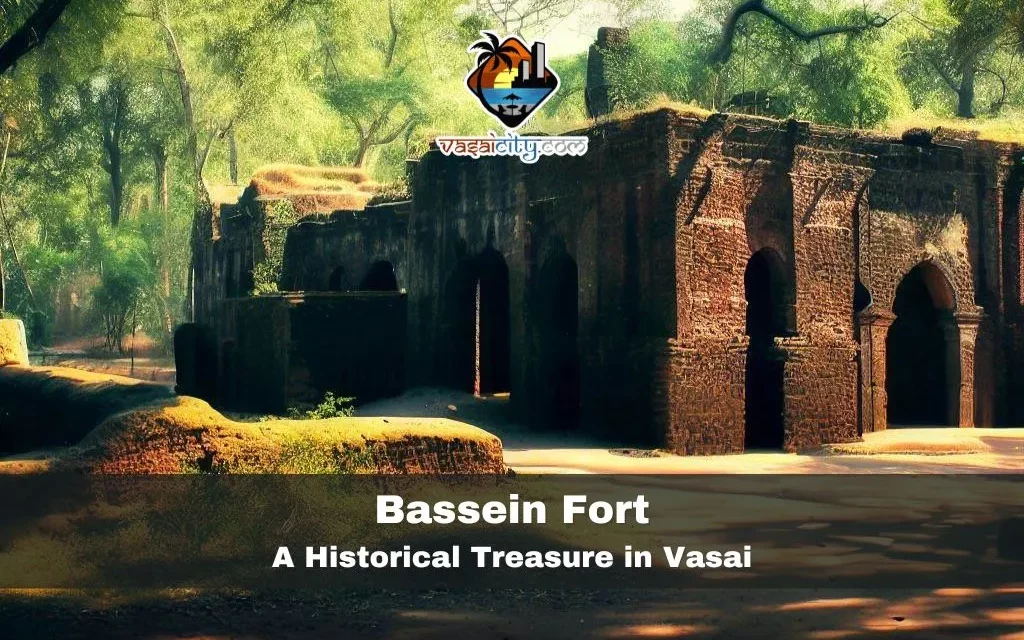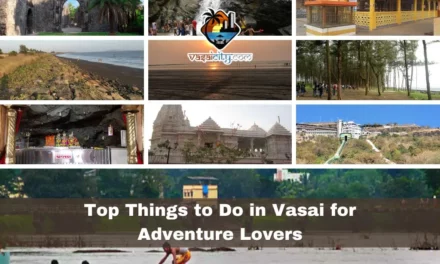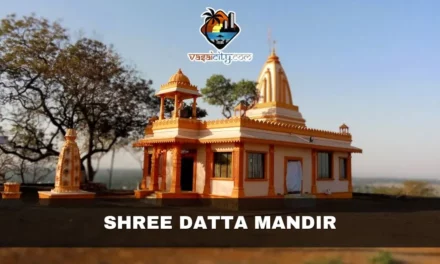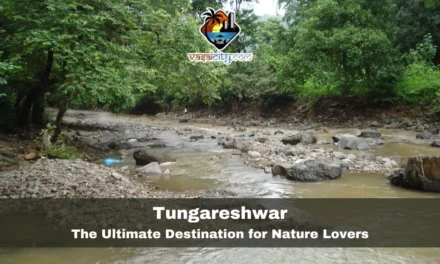Bassein Fort, also known as Vasai Fort, is one of the most fascinating historical monuments in Maharashtra. Located in the town of Vasai, about 50 km north of Mumbai, this fort was once the stronghold of the Portuguese in north Konkan. It witnessed many battles and sieges over the centuries, and today it stands as a testimony to the glorious and turbulent past of Maharashtra.
In this article, we will take you on a journey through the history and architecture of Bassein Fort, and also give you some tips on how to visit this amazing place.
Table of Contents
The History of Bassein Fort
Bassein Fort has a long and rich history that dates back to the 12th century. It was originally built by the Yadavas of Devagiri, who ruled over the Konkan region. It was later conquered by the Gujarat Sultanate in 1432, and then by the Portuguese in 1534.
The Portuguese renamed it as Fortaleza de São Sebastião de Baçaim (Fort of St. Sebastian of Bassein) and made it their headquarters for their operations in north Konkan. They also built several churches, monasteries, administrative buildings and private quarters inside the fort.
The fort was strategically located near the mouth of the Ulhas River and the Arabian Sea, and it served as a naval base and a trading centre for the Portuguese. It also played a key role in spreading Christianity in India, as many missionaries and saints visited and stayed at the fort.
The fort witnessed many battles and sieges over the centuries, especially between the Portuguese and the Marathas. The most famous one was the Battle of Vasai in 1739, when the Maratha army led by Chimaji Appa defeated the Portuguese and captured the fort. The Marathas held the fort until 1818, when it was taken over by the British East India Company.
The British did not pay much attention to the fort, and it gradually fell into decay and ruin. After India gained independence in 1947, the fort was declared as a monument of national importance and was protected by the Archaeological Survey of India.
The Architecture of Bassein Fort
Bassein Fort is spread over an area of about 110 acres and is surrounded by a moat and thick stone walls. The fort has three main entrances: one facing the land, one facing the sea and one facing the river. The main entrance facing the land is called Porta do Mar (Sea Gate) and has a coat of arms of Portugal above it.
Inside the fort, you can see the ruins of various structures that reflect the architectural styles of different eras. Some of the most notable ones are:
- The Citadel: This is the innermost part of the fort where the Portuguese governor used to reside. It has a large courtyard with a fountain and a well. It also has a chapel dedicated to St. Sebastian, after whom the fort was named.
- The Churches: There are several churches inside the fort that were built by the Portuguese for their religious purposes. Some of them are: St. Joseph’s Church, Our Lady of Grace Church, Our Lady of Life Church, Our Lady of Remedies Church and Holy Name of Jesus Church. These churches have beautiful altars, paintings and sculptures that showcase the art and culture of Portugal.
- The Monasteries: There are two monasteries inside the fort that were used by different religious orders. One is called Convento de São Francisco (Convent of St. Francis) and was used by Franciscan friars. The other is called Convento de Santo António (Convent of St. Anthony) and was used by Augustinian friars. These monasteries have spacious halls, cells and cloisters where the monks used to live and pray.
- The Administrative Buildings: There are also some administrative buildings inside the fort that were used by the Portuguese for their civil and military affairs. Some of them are: Casa do Governador (Governor’s House), Casa do Secretário (Secretary’s House), Casa da Câmara (Town Hall), Casa da Fazenda (Treasury House) and Casa da Pólvora (Powder House). These buildings have arched windows, balconies and terraces that offer scenic views of the surroundings.
How to Visit Bassein Fort
If you are planning to visit Bassein Fort, you can reach it by train or by road. The nearest railway station is Naigaon on the Western Railway line, which is about 3 km from the fort. You can also take a bus or a taxi from Mumbai or Thane to Vasai and then hire an auto-rickshaw or a bicycle to reach the fort.
The best time to visit Bassein Fort is during the monsoon season, from July to January, when the fort and its surroundings are covered with lush greenery and flowers. The fort is open to visitors from 9 am to 7 pm every day. There is no entry fee to visit this beautiful fort.
Things to Do at Bassein Fort
Bassein Fort is a place where you can do many things, such as:
- Explore the ruins of various structures that reflect the architectural styles of different eras. You can see the citadel, the churches, the monasteries, the administrative buildings and the powder house. You can also admire the coat of arms of Portugal, the statues of saints and the paintings and sculptures that showcase the art and culture of Portugal.
- Enjoy the scenic views of the Arabian Sea and the Ulhas River from the fort walls. You can also see the Vasai Creek Bridge, which connects Vasai and Mumbai. You can also spot some birds and animals, such as peacocks, monkeys and squirrels.
- Learn about the history and culture of Maharashtra and its interaction with other regions and countries. You can read about the battles and sieges that took place at the fort, and how it changed hands over time. You can also learn about the role of Bassein Fort in spreading Christianity in India, and how it influenced the local culture and language.
- Take some amazing photos and videos of the fort and its surroundings. You can capture some stunning shots of the fort against the backdrop of the sky, the sea and the river. You can also take some selfies and group photos with your friends and family.
- Have a picnic or a snack at the fort premises. You can bring your own food and drinks, or buy some from nearby stalls. You can also find some water taps and toilets at the fort. You can enjoy your meal while sitting on the grass or on a bench.
Tips for Visiting Bassein Fort
Here are some tips for visiting Bassein Fort:
- Carry your food and snacks compulsorily as there are no outlets available in immediate vicinity of the fort.
- Wear a cap or put on some sun protection lotion to save your skin some sun damage.
- During visits in the heavy rainy season, the place around is covered in greenery, bushes and shrubs. There are chances of snakes and other insects’ common in that season. So, avoid trips during evening time in rainy season for your own safety.
- You’ll get some great clicks for you profile pictures for a long time in the backdrop of this jewel of architecture.
- There are a lot of European travelers around the place usually. Have fun interacting with them and making them realize what a beauty Maharashtra is.
- There is a very old Church too inside the fort that makes for a nice eerie picture and worship.
- The place is a bit too tedious for older people and they might suffer problems in moving around the place. Keep that in mind and plan accordingly.
- Do not litter around the place and help maintain the elegance of the fort and its surrounding areas.
- Do not write anything or carve using sticks on the monument or its adjacent structures.
- There are absolutely no sign boards or historic plates conveying the relevance behind the place. Keep that in mind and explore the place around to your maximum benefit.
- If you are among the thimble hearted, do not visit after the sun has set as this place is deserted and has that eerie feel about itself.
Conclusion
Bassein Fort is a must-see destination for history buffs and nature lovers alike. It is a place where you can learn about the glorious and turbulent past of Maharashtra, and also enjoy some peace and tranquility away from the hustle and bustle of the city. It is a place that will make you appreciate the beauty and diversity of India, and its rich cultural heritage.
So, what are you waiting for? Plan your trip to Bassein Fort and experience the magic of this historical treasure in Vasai. You will not regret it!
References
- Fort Vasai – Wikipedia. (n.d.). Retrieved from https://en.wikipedia.org/wiki/Fort_Vasai
FAQ on Bassein Fort
-
What is Bassein Fort?
Bassein Fort, also known as Vasai Fort, is a historical monument in Vasai, Maharashtra, that showcases the architectural and cultural legacy of the Portuguese, the Marathas and the British.
-
When was Bassein Fort built and by whom?
Bassein Fort was originally built by the Yadavas of Devagiri in the 12th century. It was later conquered by the Gujarat Sultanate in 1432, and then by the Portuguese in 1534. The Portuguese renamed it as Fortaleza de São Sebastião de Baçaim (Fort of St. Sebastian of Bassein) and made it their headquarters for their operations in north Konkan.
-
What are some of the structures that can be seen at Bassein Fort?
Some of the structures that can be seen at Bassein Fort are:
The Citadel: This is the innermost part of the fort where the Portuguese governor used to reside. It has a large courtyard with a fountain and a well. It also has a chapel dedicated to St. Sebastian, after whom the fort was named.
The Churches: There are several churches inside the fort that were built by the Portuguese for their religious purposes. Some of them are: St. Joseph’s Church, Our Lady of Grace Church, Our Lady of Life Church, Our Lady of Remedies Church and Holy Name of Jesus Church. These churches have beautiful altars, paintings and sculptures that showcase the art and culture of Portugal.
The Monasteries: There are two monasteries inside the fort that were used by different religious orders. One is called Convento de São Francisco (Convent of St. Francis) and was used by Franciscan friars. The other is called Convento de Santo António (Convent of St. Anthony) and was used by Augustinian friars. These monasteries have spacious halls, cells and cloisters where the monks used to live and pray.
The Administrative Buildings: There are also some administrative buildings inside the fort that were used by the Portuguese for their civil and military affairs. Some of them are: Casa do Governador (Governor’s House), Casa do Secretário (Secretary’s House), Casa da Câmara (Town Hall), Casa da Fazenda (Treasury House) and Casa da Pólvora (Powder House). These buildings have arched windows, balconies and terraces that offer scenic views of the surroundings. -
How can one reach Bassein Fort?
One can reach Bassein Fort by train or by road. The nearest railway station is Naigaon on the Western Railway line, which is about 3 km from the fort. One can also take a bus or a taxi from Mumbai or Thane to Vasai and then hire an auto-rickshaw or a bicycle to reach the fort.
-
When is the best time to visit Bassein Fort?
The best time to visit Bassein Fort is during the monsoon season, from July to January, when the fort and its surroundings are covered with lush greenery and flowers.
-
What are some of the things to do at Bassein Fort?
Some of the things to do at Bassein Fort are:
– Explore the ruins of various structures that reflect the architectural styles of different eras.
– Enjoy the scenic views of the Arabian Sea and the Ulhas River from the fort walls.
– Learn about the history and culture of Maharashtra and its interaction with other regions and countries.
– Take some amazing photos and videos of the fort and its surroundings.
– Have a picnic or a snack at the fort premises. -
Is there any entry fee or visiting time for Bassein Fort?
There is no entry fee or visiting time for Bassein Fort. The fort is open to visitors from 9 am to 7 pm every day.









